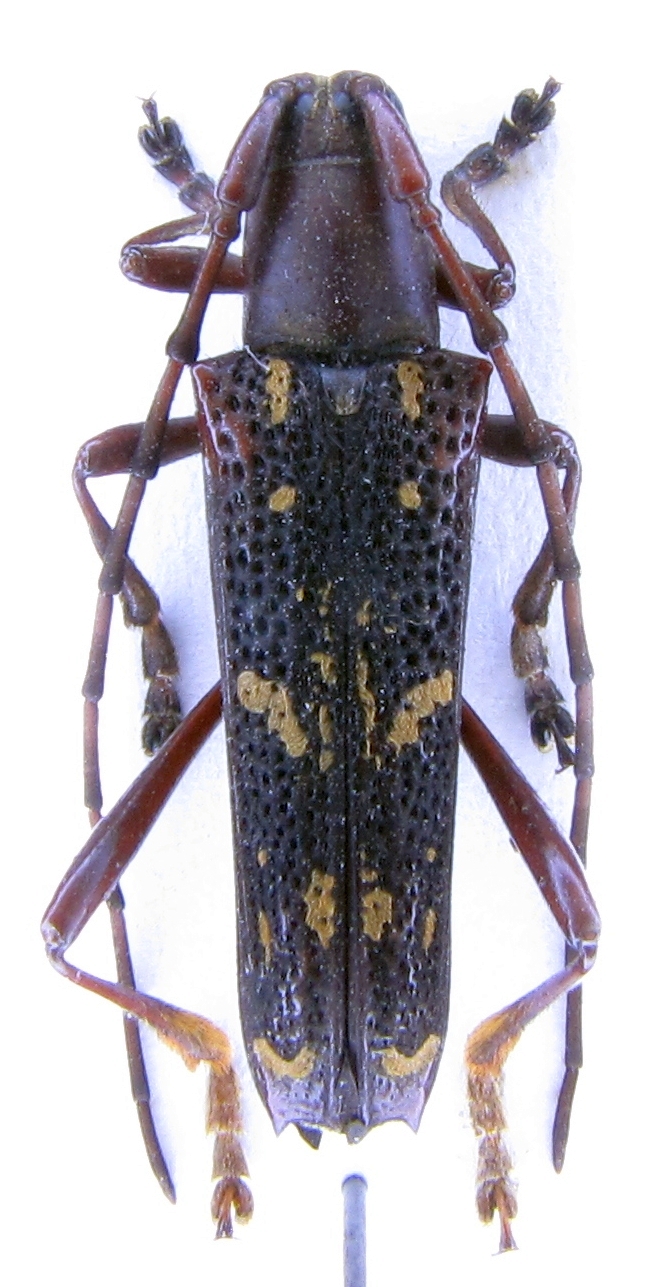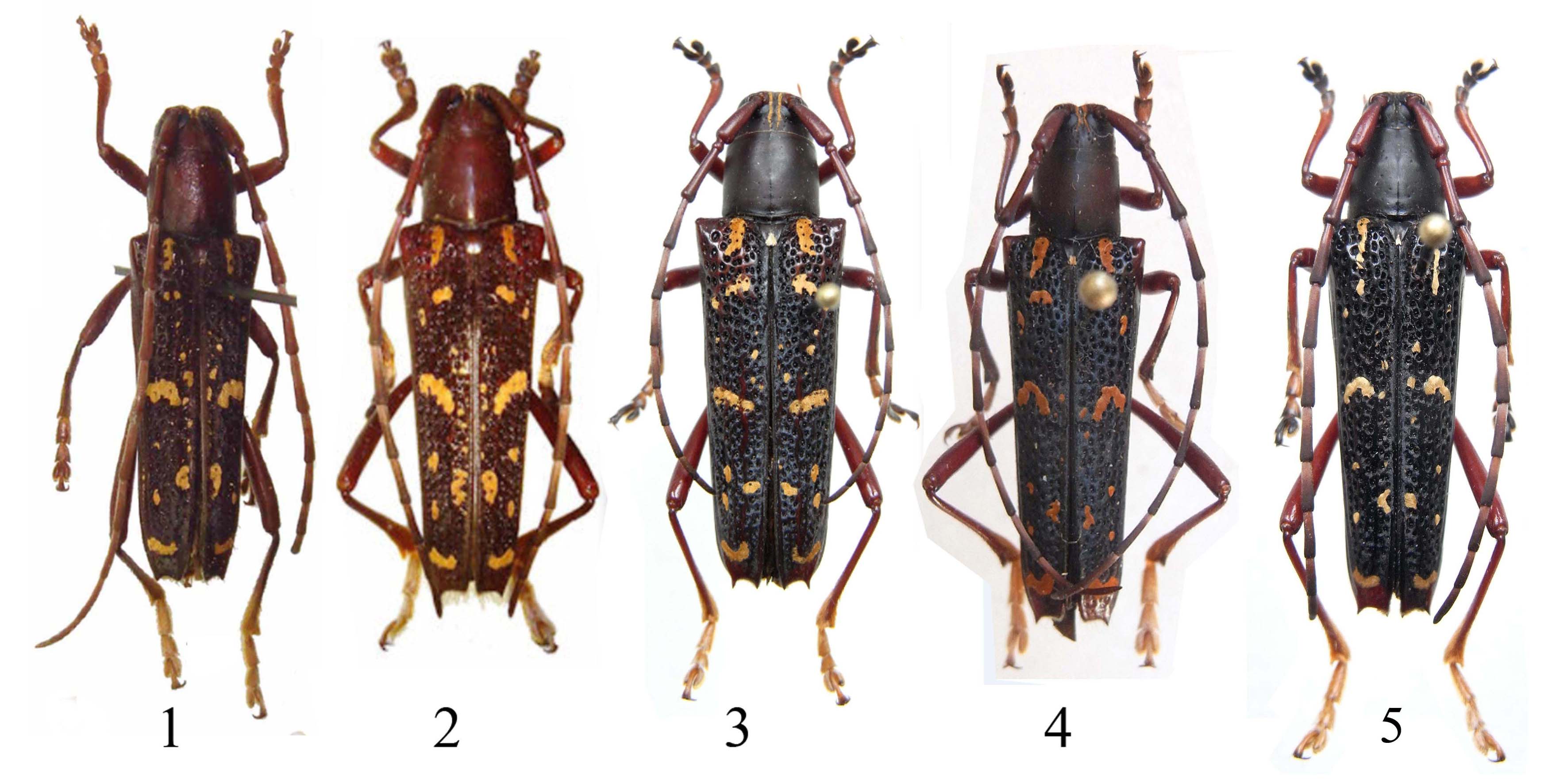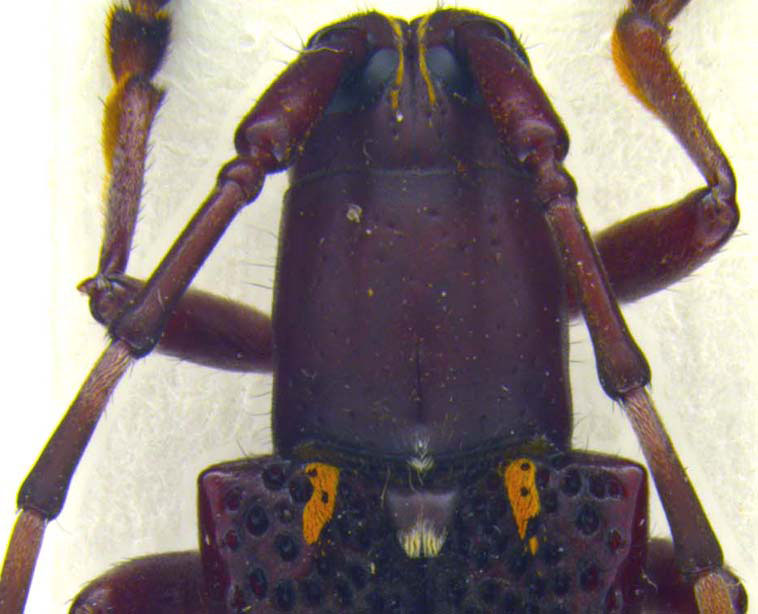| T O P I C R E V I E W |
| Xaurus |
Posted - 07/01/2016 : 23:30:23

206.92áKB
This spm should be G. nigrorubricollis Lin & Yang, 2009 (19 mm), not yet known from Vietnam, but I'm not happy with this species complex together with G. subrubricollis and G. rubricollis acc Lin et al. 2009 |
| 15 L A T E S T R E P L I E S (Newest First) |
| Vitali |
Posted - 28/01/2023 : 20:58:23

459.96 KB
I am adding my specimen here. Vietnam, Ha Giang.
The antennae (scape = segment 3 = segment 4, the exact ratio is 52:52:50 in arbitary units) and the shape of median pubescent macula fully correspond to the Lin's description of G. subrubricollis.
If the antennae measures given by Andreas are also correct, I would better also join Riana's club of African Cerambycidae reseachers... though there are Eunidia and Sophronica. |
| Xavier |
Posted - 25/01/2023 : 19:54:21
quote:
Originally posted by Riana
I must admit I am so glad to reside and work on African cerambycids....
 |
| Riana |
Posted - 25/01/2023 : 19:19:45
I must admit I am so glad to reside and work on African cerambycids....
|
| Xavier |
Posted - 25/01/2023 : 15:13:50
Thanks, I created a new post here for the specimen n░3. Give me your opinion... |
| Vitali |
Posted - 25/01/2023 : 15:06:36
It is in the Diagnosis for G. subrubricollis: "Differs from G. nigrorubricollis Lin et Yang sp. nov in ... median pubescent macula on elytron with different shape and pubescent spots on abdominal segments all orange"
Difficult. Nr. 4 and 5 seem to correspond more to G. nigrorubricollis, but nr. 3 is different and, by the way, it has also fourth antennomere shorter than the third one. Is this a feature of a female? |
| Xavier |
Posted - 25/01/2023 : 14:29:00

404.54áKB
1 Glenea nigrorubricollis Lin & Yang, 2009 HT
2 Glenea subrubricollis Lin & Tavakilian, 2009 HT
3 Glenea sp. Vietnam female
4 Glenea sp. Laos male
5 Glenea sp. Vietnam male
About the shape of the median macule, Lin does not give any details, and only says that it is "different" than a "a median rather large and transverse spot".
Next to the two Holotype specimens, here are three specimens from Vietnam and Laos, with an even different macule shape. By the length of the antennae, my two males are probably Glenea subrubricollis Lin & Tavakilian, 2009. No idea for the female. |
| Vitali |
Posted - 25/01/2023 : 11:33:12
Based on a bit slenderer third antennomere and the shape of median pubescent macula on elytron, which is also used as a diagnostic character in Lin's paper, I would vote for G. nigrorubricollis.
The length of antennae in males is so subtle character that I hardly can see any difference between G. nigrorubricollis and G. subrubricollis even in the male photos shown in the original paper. |
| Xaurus |
Posted - 24/01/2023 : 00:25:46
My spms is a male, with measured parts:
scapus=2,1mm
3rd segment=2,1mm
4th segment=2,0mm
ratio lower eye lobes/cheeks ~ 1,9
- nearly the same for further 4 males !!
which species ??
|
| Xavier |
Posted - 23/01/2023 : 17:32:55
Yes, posssible, I do not know.

98.94 KB |
| Vitali |
Posted - 23/01/2023 : 13:52:41
Yes, it is difficult with a photo. Unlike the third and forth antennal segments, the scape is visible under some angle. It seems to be shorter. |
| Xavier |
Posted - 23/01/2023 : 12:59:29
I just see(?) that this specimen has length of scape = segment 3 = segment 4. |
| Vitali |
Posted - 23/01/2023 : 10:56:11
Hello! I am trying to identify my specimen of Rubroglenea, and thus came to this older post.
Xavier, if stretched the antennae of this specimen are longer than the body. Why did you stay with the name Glenea subrubricollis? |
| Xavier |
Posted - 06/07/2020 : 08:20:19
Male of G. nigrorubricollis has antenna longer than the body.
Your specimen is Glenea subrubricollis Lin & Tavakilian, 2009. |
| Xavier |
Posted - 10/01/2018 : 11:12:55
If I understand something:
Glenea subrubricollis male: length of scape = segment 3 = segment 4; lower lobe of the eye slightly longer than cheek.
Glenea nigrorubricollis male: scape shorter than segment 3 or 4; lower lobe of the eye 2 times longer than cheek.
For the rest, when reading the descriptions, there is no difference in hairs, punctuation, colour, spots and stripes between the two species. |
| Xavier |
Posted - 10/01/2018 : 09:46:41
I am not able to separate on picture G. subrubricollis & G. nigrorubricollis ! |


